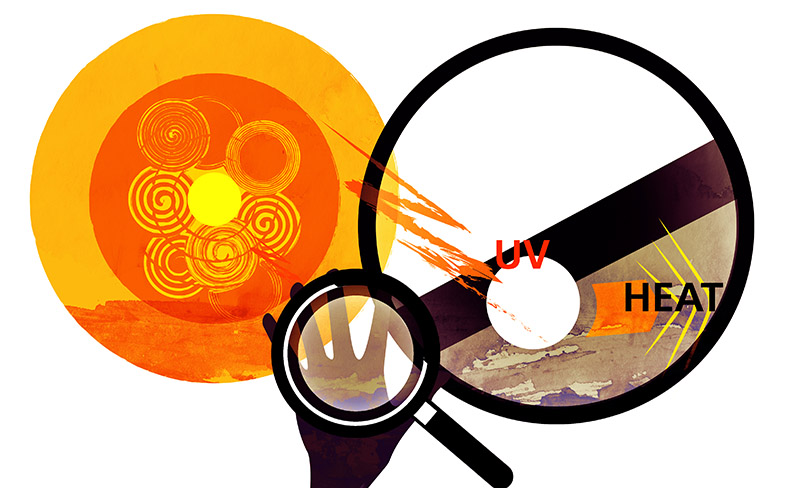Skin pigment neutralises UV radiation from the sun through projectiles
Researchers at Lund University and others have shown that skin pigments convert UV radiation into heat through a speedy chemical reaction that blasts protons from the pigment molecules. The skin pigment thereby protects the body from hazardous UV radiation from the sun.
Researchers at Lund University, together with colleagues in France and Italy, have studied skin pigment and its components. Pigments in both skin and hair are composed of two different melanins: Eumelanin and pheomelanin. Eumelanin makes us tanned and adds colour to brown or black hair, while red-haired people with light skin tones instead have large amounts of pheomelanin.
“We found that eumelanin converts harmful UV radiation into heat with nearly 100 per cent efficiency. The chemical reaction is extremely fast – less than a thousandth of a billionth of a second”, says Villy Sundström, Professor of Chemistry at Lund University.
SPECIFICALLY WHAT HAPPENS during the chemical reaction is that a hydrogen ion is kicked out from the pigment the moment the UV light reaches the pigment molecule. The process could be described as melanin doing away with ultraviolet light energy by rapidly launching a proton projectile. In turn, this projectile releases energy to the surrounding tissue membrane in the form of heat, and has thereby converted dangerous UV energy into harmless heat.
“This way, the pigment disarms the energy in the UV radiation, and prevents it from causing harmful chemical reactions”, says Villy Sundström.
EUMELANIN IS CONSIDERED TO BE THE PIGMENT THAT PROTECTS against UV radiation, while pheomelanin is believed to somehow be the cause of skin cancer, which explains why people with red hair have a greater risk of developing malignant melanoma. However, researchers have so far not had any knowledge of which chemical reactions in the pigment are caused by UV light. Therefore, knowledge about which pigment processes have a protective effect, respectively causes illness, has so far been missing.
“By understanding how nature protects itself against UV light, we can develop new and improved sun screen products that are based on the same principles, and thereby obtain better protection against skin cancer etc.”, says Villy Sundström.
The idea is to ultimately find treatments and substances to replace the natural pigment in people suffering from a deficient production of eumelanin. Eumelanin consists of two similar components, but only one of them generates a protective effect. This shows that it is very specific; it is about small differences in the chemical structure of the components. This insight can be important when developing substances to be used for treatment, and as sunscreen products.
Text: Lena Björk Blixt
Published: 2014
Illustration: Catrin Jakobsson
Facts
-
When UV light causes malignant melanoma
-
Skin cancer is the fastest growing type of cancer. Most cases of melanoma are believed to be caused by sun and tanning bed burns. Other risk factors include being light-skinned and red-haired, and having many birth marks. Heredity plays a role in certain cases: Between five and ten per cent of all cases of malignant melanoma are considered to have a hereditary background. Approximately 3 300 new cases of malignant melanoma occur each year, and over 500 patients die from the cancer spreading to other organs. However, if the disease is detected at an early stage, it is very easy to cure. Better protection against UV radiation and earlier detection would reduce mortality significantly.
-
Caption
-
Our skin contains the colour pigment melanin, and the browner your skin is, the more melanin you have. Melanin protects us from energy-rich UV radiation by converting dangerous light energy into harmless heat. When the energy from the UV radiation reaches the melanin molecule, the melanin is quick to dispose of a hydrogen ion – a proton – which is fired off like a projectile. This projectile in turn disposes of the energy to the surrounding membrane tissue in the form of heat.


